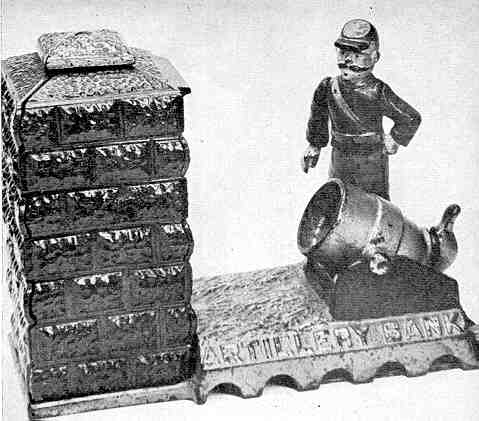Artillery Bank
by F.H. Griffith - HOBBIES Magazine - April, 1971

A really nice fort and cannon type bank is our choice as No. 196 in the numerical classification. This bank is the well known Artillery Bank, a fine product of, unusually enough, two different companies. It was first manufactured by Shepard Hardware of Buffalo, N.Y. and then J. & E. Stevens Company of Cromwell, Conn.
The Artillery was patented May 31, 1892, quoting the patent, "Charles G. Shepard and Peter Adams of Buffalo, N.Y., said Adams assignor to Walter J. Shepard, of same place." This is a design patent and, of course, covered the design or configuration of the bank. The drawing in the patent is practically identical to the bank as actually produced. It might be well to point out that while this bank is in the fort and cannon group of banks, the structure into which the cannon fires the coin is not technically a fort as such.
The patent refers to this structure as being a "wall or tower." In any case, the bank was first manufactured by the Shepard Hardware Company of Buffalo. At a later date Stevens took over the manufacture of certain Shepard mechanical banks including the Artillery, which they made for the duration of the years it was manufactured. It is not known for certain if both companies made the Artillery simultaneously for any given period of time. Evidence would indicate that when Stevens started making the Artillery, Shepard stopped. We do know that Stevens made the bank long after Shepard had ceased its manufacture.
Although the Artillery Banks look identical as made by each company, there is a very easy way to tell them apart. The Shepard Artillery has their often used rectangular shaped key lock coin trap in the base. The Stevens Artillery has their usual round pressure held type coin trap. Other than this, Stevens used the same patterns as utilized by Shepard. As a matter of fact, on the coin section base of the Stevens Artillery the rectangular outline of the Shepard coin section is plainly visible. Stevens simply filled in this section on the patterns making it adaptable to the usage of their round trap. This coin trap section is underneath the structure into which the coins are fired or propelled by the cannon.
The bank shown is a fine original condition example of the Stevens Artillery. This bank has the Southern painted type soldier with the gray hat and trousers. It more commonly comes with the Northern type soldier with blue hat and trousers. Complete colors on the bank pictured are as follows: The stone-like building is a dark japanned type finish with the square raised top in gold. The base section in front of the building represents grass and it is green with highlighting of yellow and red. The name "Artillery Bank" is in old block lettering. By the way, the section of the base on which the building is situated is the same green as the rest of the base. The side sections of the cannon or mortar are brown. At this point it might be well to point out that the cannon is actually a mortar. In any case, it is painted in gold, as is the large hammer and trigger that operates the bank. The figure of the soldier wears a gray hat with black visor edged in white and a yellow band around the back. He has flesh color hands and face with a large black moustache. He wears a red jacket with dark blue collar and straps are yellow. His trousers are gray and shoes black. His black hair finishes the coloring of the bank.
To operate the Artillery the large hammer of the mortar is pulled down into position. In so doing the right arm of the soldier is caused to move to a horizontal position. A coin is then placed inside the barrel of the mortar. The lever, located by the letter "K" in the name, is then pressed down, the soldier’s arm drops signaling the firing of the mortar, the hammer snaps up and strikes the coin propelling it into the provided opening in the building. The coin seldom misses its mark. The mortar and hammer are made in such fashion to accommodate a paper firing cap so that a loud noise can accompany the action.
On the underside of the base plate of the bank in the section beneath the soldier and mortar is inscribed "Pat. May 31, 1892." In closing, it also bears mention that the Artillery, as well as painted in colors, was made with an electrolytic bronze finish and a nickel plated finish. Both these type finishes, bronze or nickel, are the earliest of the Artillery Banks and only made by Shepard. All that the writer has seen so far in nickel or bronze have the rectangular locking coin trap as used by Shepard. It is possible that Stevens could have made the bank with a nickel finish, but, to the best of the writer’s knowledge, this is not the case. Stevens did not produce the bank with a bronze finish. They only finished it in colors from all evidence of their old catalogs, specimens known to exist, and so on.
